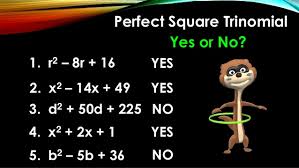Overview
Factoring polynomials in general is the reverse process of multiplying them, and then finding common factors. However, some polynomials follow special patterns, such as the difference of two squares and trinomial squares, leading to shortcut methods of factoring.
Recognizing the Difference of Two Squares
In order for a polynomial to be the difference of two squares, there must be two terms in the polynomial (a binomial), both terms in the binomial must be perfect squares, and there must be a minus sign between them. For example, the binomial x2 -16 has two terms in the binomial, there is a minus sign between them, and both x2 and 16 are perfect squares, as the square root of x2 is x, and the square root of 16 is 4. Suppose the polynomial were x4 +81. Although it is a binomial, and both x4 and 81 are perfect squares, there is a plus sign between them, so it doesn’t satisfy all the conditions. Suppose the polynomial was 4x2 – 10. The monomial 4x2 is a perfect square (2x), the expression is a binomial, and there is a minus sign between them. However, 10 is not a perfect square, so it is not the difference of two squares. Suppose the expression is -9x2 +25. It can be turned around, using the commutative property, so that the expression becomes 25-9x2. It is a binomial, the minus sign is between the two terms, and both 25 and 9x2 are perfect squares, as the square root of 25 is 5 and the square root of 9x2 is 3x.
Factoring the Difference of Two Squares
Recall from the discussion of special products of polynomials that the product of (x +y) (x-y) equals x2 – y2 because xy and –xy cancel each other out. Therefore, a binomial such as x2 –y2 can be factored so that it follows the pattern (x +y) (x-y). For example, the binomial 16x2 – 81 follows the pattern of the difference of two squares, and can be factored as (4x +9)(4x-9) because the square root of 16x2 is 4x and the square root of 81 is 9.
Recognizing Trinomial Squares
Trinomial squares also follow special conditions. Recall from the discussion of special products of polynomials that (x +y) 2 is always a trinomial in the form of x2 +2xy +y2. Similarly, (x-y) 2 is always a trinomial in the form x2 -2xy + y2. Therefore, a trinomial is a trinomial square if two of the terms are perfect squares, there are no minus signs before either of them, and the other term is twice the product of the first two. For example, x2 +6x +9 fits the pattern because both x2 and 9 are perfect squares. The square root of x2 is x, the square root of 9 is 3, and 3x + 3x is 6x.
Factoring Trinomial Squares
After recognizing a trinomial square, it is a short step to factoring it. For example, since both x2 and 9 are perfect squares, the square root of x2 is x and the square root of 9 is 3. To check, multiply (x + 3) (x + 3) using FOIL, for x2 + 3x +3x = 9, or x2 + 6x +9.
Interested in math tutoring services? Learn more about how we are assisting thousands of students each academic year.
SchoolTutoring Academy is the premier educational services company for K-12 and college students. We offer tutoring programs for students in K-12, AP classes, and college. To learn more about how we help parents and students in Wichita, KS: visit: Tutoring in Wichita, KS





